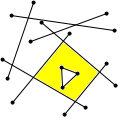|
CGAL 4.14 - 2D Arrangements
|
|
CGAL 4.14 - 2D Arrangements
|

Given a set \( \mathcal{C}\) of planar curves, the arrangement \( {\mathcal A}({\mathcal C})\) is the subdivision of the plane induced by the curves in \( \mathcal{C}\) into maximally connected cells. The cells can be \( 0\)-dimensional (vertices), \( 1\)-dimensional (edges) or \( 2\)-dimensional (faces).
The class Arrangement_2<Traits,Dcel> encapsulates a data structure that maintains arrangements of arbitrary bounded planar curves. It comes with a variety of algorithms that operate on planar arrangement, such as point-location queries and overlay computations, which are implemented as peripheral classes or as free (global) functions.
ArrangementDcelArrangementDcelWithRebindArrangementDcelVertexArrangementDcelHalfedgeArrangementDcelFaceArrangementDcelHoleArrangementDcelIsolatedVertexArrangementBasicTraits_2ArrangementLandmarkTraits_2ArrangementXMonotoneTraits_2ArrangementTraits_2ArrangementOpenBoundaryTraits_2ArrangementInputFormatterArrangementOutputFormatterArrangementWithHistoryInputFormatterArrangementWithHistoryOutputFormatterArrangementPointLocation_2ArrangementVerticalRayShoot_2ArrTraits::CompareX_2ArrTraits::CompareXy_2ArrTraits::ConstructMinVertex_2ArrTraits::ConstructMaxVertex_2ArrTraits::IsVertical_2ArrTraits::CompareYAtX_2ArrTraits::CompareYAtXLeft_2ArrTraits::CompareYAtXRight_2ArrTraits::Equal_2ArrTraits::ParameterSpaceInX_2ArrTraits::ParameterSpaceInY_2ArrTraits::CompareXAtLimit_2ArrTraits::CompareXNearLimit_2ArrTraits::CompareYNearBoundary_2ArrTraits::Intersect_2ArrTraits::Split_2ArrTraits::AreMergeable_2ArrTraits::Merge_2ArrTraits::MakeXMonotone_2ArrTraits::Approximate_2ArrTraits::ConstructXMonotoneCurve_2CGAL::Arrangement_2<Traits,Dcel>CGAL::Arr_accessor<Arrangement>CGAL::Arr_observer<Arrangement>CGAL::Arrangement_with_history_2<Traits,Dcel>CGAL::Arrangement_2::VertexCGAL::Arrangement_2::HalfedgeCGAL::Arrangement_2::FaceCGAL::Arr_dcel_base<V,H,F>CGAL::Arr_default_dcel<Traits>CGAL::Arr_face_extended_dcel<Traits,FData,V,H,F>CGAL::Arr_extended_dcel<Traits,VData,HData,FData,V,H,F>CGAL::Arr_segment_traits_2<Kernel>CGAL::Arr_non_caching_segment_traits_2<Kernel>CGAL::Arr_linear_traits_2<Kernel>CGAL::Arr_polyline_traits_2<SegmentTraits>CGAL::Arr_circle_segment_traits_2<Kernel>CGAL::Arr_line_arc_traits_2<CircularKernel>CGAL::Arr_circular_arc_traits_2<CircularKernel>CGAL::Arr_circular_line_arc_traits_2<CircularKernel>CGAL::Arr_conic_traits_2<RatKernel,AlgKernel,NtTraits>CGAL::Arr_rational_function_traits_2<AlgebraicKernel_d_1>CGAL::Arr_Bezier_curve_traits_2<RatKernel,AlgKernel,NtTraits>CGAL::Arr_algebraic_segment_traits_2<Coefficient>CGAL::Arr_curve_data_traits_2<Tr,XData,Mrg,CData,Cnv>CGAL::Arr_consolidated_curve_data_traits_2<Traits,Data>CGAL::Arr_text_formatter<Arrangement>CGAL::Arr_face_extended_text_formatter<Arrangement>CGAL::Arr_extended_dcel_text_formatter<Arrangement>CGAL::Arr_with_history_text_formatter<ArrFormatter>CGAL::Arr_naive_point_location<Arrangement>CGAL::Arr_walk_along_line_point_location<Arrangement>CGAL::Arr_trapezoid_ric_point_location<Arrangement>CGAL::Arr_landmarks_point_location<Arrangement,Generator>CGAL::Arr_vertex_index_map<Arrangement>CGAL::Arr_face_index_map<Arrangement>CGAL::Arr_point_location_result<Arrangement>CGAL::is_valid()CGAL::insert()CGAL::insert_non_intersecting_curve()CGAL::insert_non_intersecting_curves()CGAL::insert_point()CGAL::remove_edge()CGAL::remove_vertex()CGAL::locate()CGAL::decompose()CGAL::overlay()CGAL::read()CGAL::write()CGAL::remove_curve()CGAL::operator<< CGAL::operator<< Modules | |
| Concepts | |
| Traits Classes | |
| DCEL | |
| I/O | |
| Point Location | |
| Overlay | |
Computes the overlay of two arrangements with history arr1 and arr2, and sets the output arrangement with history res to represent the overlaid arrangement. | |
| Free Functions | |
| Tags | |
| Macros | |
| Enumerations | |
Classes | |
| class | CGAL::Arr_accessor< Arrangement > |
| class | CGAL::Arr_face_index_map< Arrangement > |
Arr_face_index_map maintains a mapping of face handles of an attached arrangement object to indices (of type unsigned int). More... | |
| class | CGAL::Arr_observer< Arrangement > |
| class | CGAL::Arr_vertex_index_map< Arrangement > |
Arr_vertex_index_map maintains a mapping of vertex handles of an attached arrangement object to indices (of type unsigned int). More... | |
| class | CGAL::Arrangement_2< Traits, Dcel > |
| class | CGAL::Arrangement_with_history_2< Traits, Dcel > |